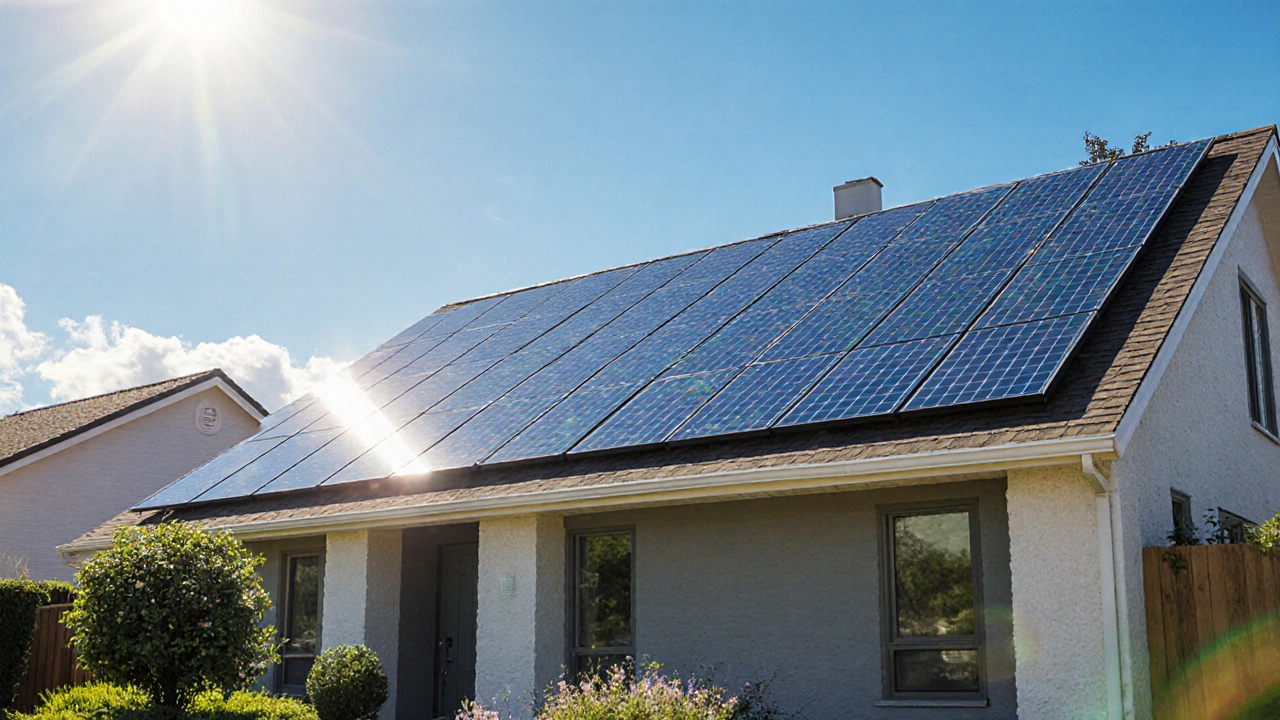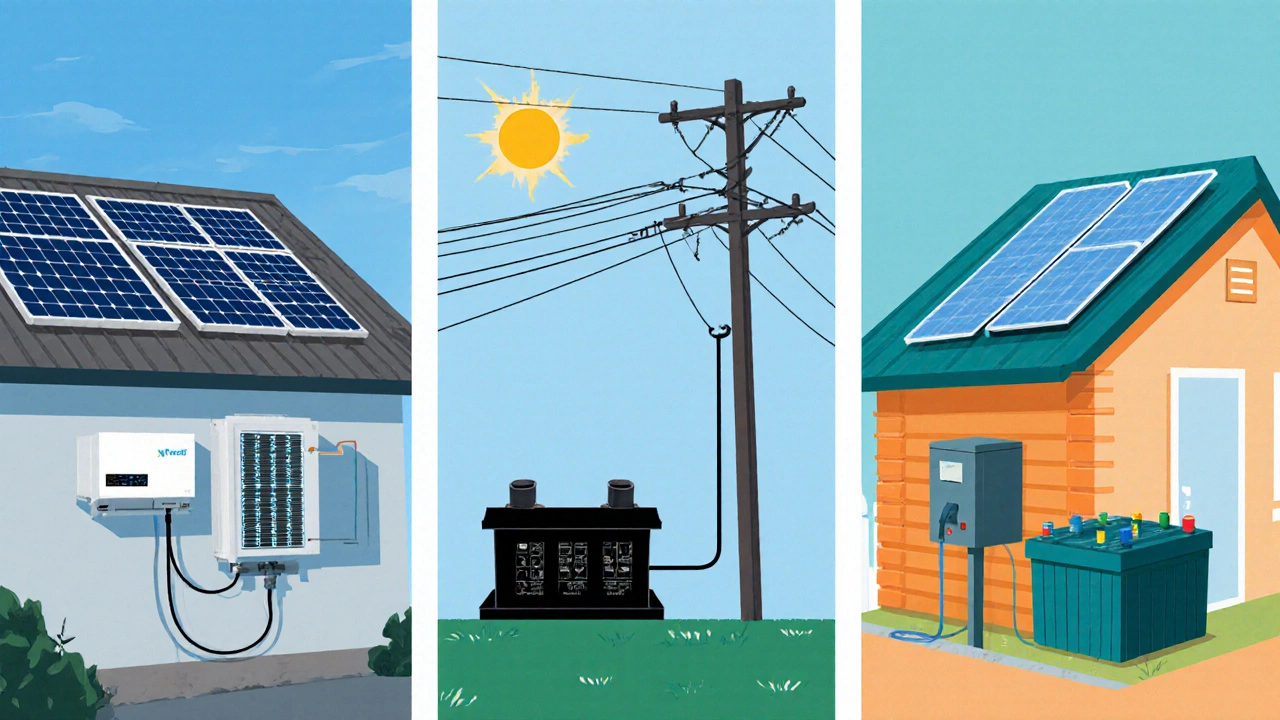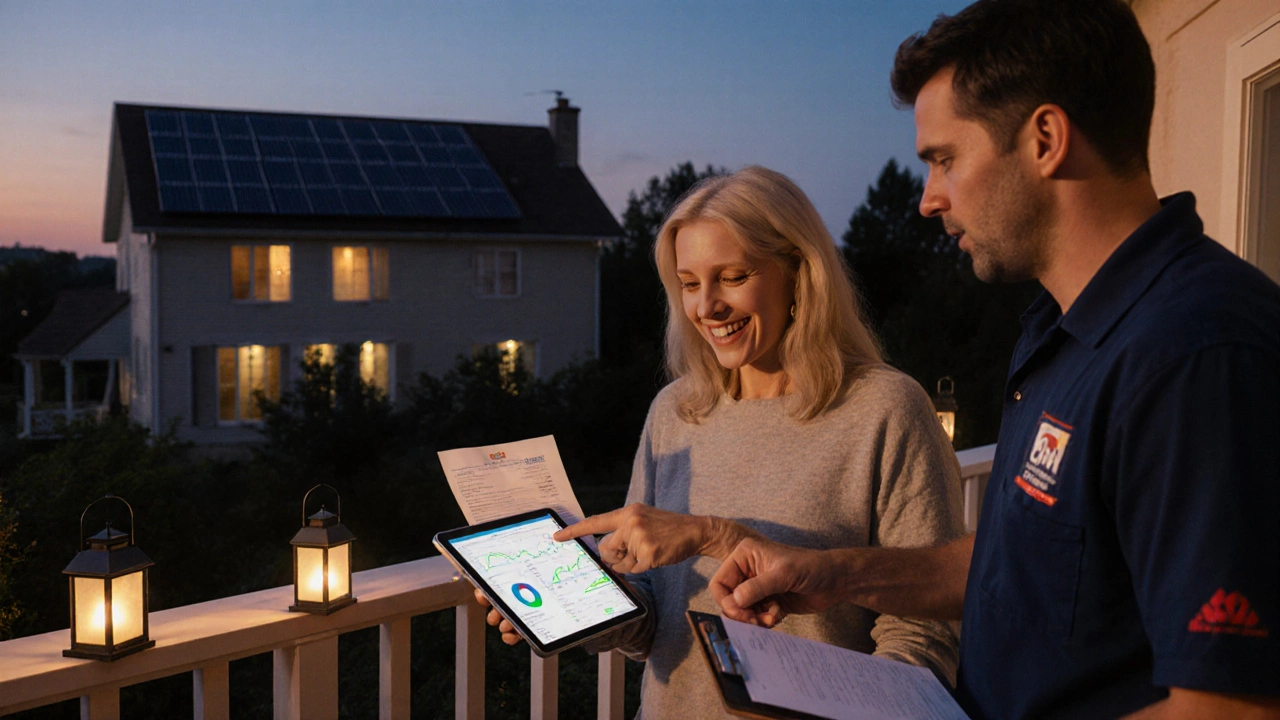Home Solar Panels: Grid‑Tied, Off‑Grid & Hybrid Explained
 Oct, 22 2025
Oct, 22 2025
Home Solar Panels are photovoltaic (PV) modules installed on residential rooftops to capture sunlight and turn it into electricity for household use. They can be hooked up to the public electricity network, stand alone, or blend both approaches. If you’re thinking about installing home solar panels, you first need to know how they connect, what you’ll need on site, and which financial rules apply.
Three Main Connection Styles
Residential PV systems fall into three families: Grid‑tied System feeds electricity directly to the utility grid and draws power when the panels aren’t producing enough, Off‑grid System operates independently of the grid, relying on batteries and backup generators for continuous supply, and Hybrid System combines grid connection with on‑site storage, letting you switch between sources based on price or availability. Each style ties the panels to a different set of hardware, contracts and regulations.
How Grid‑Tied Systems Work
A grid‑tied installation links the PV array to an Inverter that converts the DC power from solar cells into AC power compatible with household appliances and the grid. The inverter also monitors voltage and frequency to ensure safe synchronisation with the utility. When your panels generate more electricity than you consume, the excess is exported to the grid.
The export is counted through Net Metering a billing arrangement that credits residential producers for the electricity they supply back to the network. In the UK, the Smart Export Guarantee (SEG) replaces the old feed‑in tariff, guaranteeing a minimum payment per kilowatt‑hour exported. Your electricity bill therefore reflects a net balance: consumption minus export credits.
Off‑Grid Essentials
Running completely off the grid means you can’t rely on a utility to fill gaps, so you need Battery Storage typically lithium‑ion or lead‑acid packs that store surplus solar energy for use at night or during cloudy periods. The battery bank is managed by a charge controller, which protects cells from over‑charging and deep discharge.
The same inverter used in grid‑tied setups is required, but it must be an “offline” or “stand‑alone” model that can create a stable AC waveform without grid reference. Many off‑grid homes also keep a diesel or propane generator as a backup for prolonged bad weather.

Hybrid Systems: Best of Both Worlds
Hybrid configurations attach the PV array to a bi‑directional inverter that can both feed the grid and charge a battery bank. When electricity rates are low (often at night), the system may charge the batteries from the grid; when rates spike, it can discharge the batteries to offset expensive grid power. This flexibility lets you maximise the value of every kilowatt‑hour.
Hybrid owners still benefit from Net Metering credits for any surplus they send back to the grid, but they also gain resilience during outages-a feature pure grid‑tied systems lack unless paired with a battery backup.
Financial & Regulatory Ties
In the United Kingdom, three main policy levers tie residential solar to the market:
- Smart Export Guarantee (SEG) - pays a set rate for exported energy; rates vary by provider.
- Reduced VAT - solar equipment bought for domestic use enjoys a 5 % VAT rate instead of the standard 20 %.
- Renewable Heat Incentive (RHI) - not directly for PV but can complement solar‑thermal setups.
Installation must comply with Building Regulations, and the inverter and wiring need Part L approval. Most installers will handle the grid connection application with your Distribution Network Operator (DNO); the process typically takes 2‑4 weeks after final inspection.
Choosing the Right Tie‑In: A Quick Checklist
- Do you already have a reliable grid connection? If yes, a grid‑tied or hybrid system is usually cheaper.
- Is your property in a location with frequent outages? Consider off‑grid or hybrid with batteries.
- What’s your budget for upfront capital? Off‑grid setups require a larger investment in storage.
- Do you want to earn income from exported power? Grid‑tied with SEG eligibility is necessary.
- Are there space constraints for battery banks? If not, a hybrid can give you storage without going fully off‑grid.

Comparison of System Types
| Attribute | Grid‑tied | Off‑grid | Hybrid |
|---|---|---|---|
| Connection | Directly linked to utility grid | Completely independent | Connected to grid with battery backup |
| Battery needed | No (optional for backup) | Yes - large bank | Yes - moderate size |
| Initial cost | Lowest | Highest | Medium‑high |
| Reliability during outage | None (unless backup) | Full | Partial (battery runs) |
| Revenue option | Yes, via SEG | No | Yes, via SEG + saved bills |
| Typical use case | Urban homes with stable grid | Remote cabins, islands | Suburban homes wanting resilience |
Common Pitfalls and How to Avoid Them
Oversizing the array. Too many panels can flood the grid with excess power, triggering lower SEG rates or requiring costly export limiting equipment. Use a solar calculator that factors in roof area, orientation, and average consumption.
Ignoring battery depth‑of‑discharge. Turning off battery management too early shortens life. Choose a battery with a built‑in management system and set a 20‑30 % safety buffer.
Skipping the DNO application. Installing without notifying the Distribution Network Operator can result in fines and a forced shutdown. Let your installer file the connection request and schedule the final inspection.
Next Steps for Homeowners
- Audit your electricity bills for average monthly usage.
- Get a professional site survey-most installers offer a free quote.
- Decide on a system type using the checklist above.
- Compare at least three installers, checking their SEG registration.
- Arrange financing: cash, green loan, or PPAs (Power Purchase Agreements).
- Schedule installation and DNO approval; expect a 2‑week commissioning window.
- Monitor performance via the inverter’s app; adjust settings if you add batteries later.
Can I switch from a grid‑tied to an off‑grid system later?
Yes, but you’ll need to add a battery bank, replace the inverter with an offline model, and obtain a new DNO permission if you keep any grid link for backup.
Do I still get SEG payments with a hybrid system?
Hybrid owners receive SEG credits for any surplus exported to the grid, just like pure grid‑tied users. Battery discharge doesn’t affect the credit calculation.
How big should my battery be for a typical UK home?
A 5‑10 kWh lithium‑ion pack usually covers evening usage for a 3‑4‑person household. Exact size depends on your night‑time load and how much you want to offset grid rates.
What permits do I need for roof‑mounted panels?
In England, you generally need Building Regulations approval and possibly planning permission if you live in a listed building or conservation area. Your installer should handle the paperwork.
Will a solar system increase my home’s value?
Studies by the UK Energy Research Centre show an average boost of £5,000‑£10,000 for a 4 kW installation, especially in regions with high electricity prices.